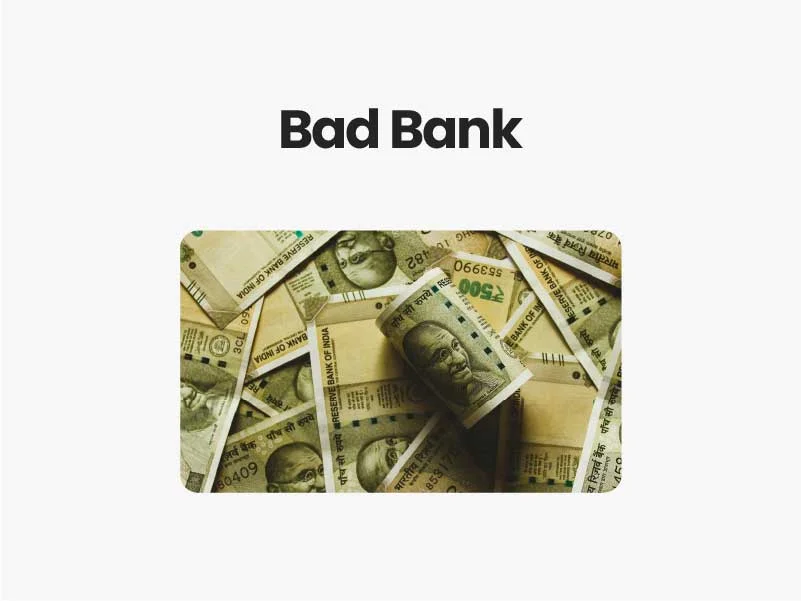
Bad Bank
Bad Bank – A recession in the Indian economy this year, due to the adverse effects of Covid-19 on economic activity. This will hit the banking and financial sector in particular, as slump in earnings of companies and individuals could lead to a jump in non-performing assets, reversing the early trends of NPA reduction post enactment of the Insolvency and Bankruptcy Code (IBC) and write-off of bad loans by banks.
- Various analysts suggest that in a couple of years, the proportion of stressed assets in the banking system could jump to as high as 18 per cent from around 11 per cent at present.
- To tackle this upcoming challenge, the banking industry has proposed the setting up of a government-backed bad bank.
Proposal of a bad bank:
- A bad bank buys the bad loans and other illiquid holdings of other banks and financial institutions, which clears their balance sheet.
- The banking sector, led by the Indian Banks Association (IBA), had in May submitted a proposal for setting up a bad bank to the finance ministry and the RBI, proposing equity contribution from the government and the banks.
- This was based on an idea proposed by a panel on faster resolution of stressed assets in public sector banks headed by former PNB Chairman Sunil Mehta.
- This panel had proposed an asset management company (AMC), ‘Sashakt India Asset Management’, for resolving large bad loans two years ago.
NPA spike is expected down the line:
- The impact of Covid-19 and the associated policy response is likely to result in an additional Rs 1,67,000 crore of debt from the top 500 debt-heavy private sector borrowers turning delinquent between FY21 and FY22, according to a report by India Ratings and Research (Ind-Ra).
- This is over and above the Rs 2,54,000 crore anticipated prior to the onset of the pandemic, taking the cumulative quantum to Rs 421,000 crore.
- Given that 11.57 per cent of the outstanding debt is already stressed, the proportion of stressed debt is likely to increase to 18.21 per cent of the outstanding quantum.
- The rating agency said in a scenario wherein funding markets continue to exhibit heightened risk aversion, corporate stress could increase further by Rs 1.68 lakh crore, resulting in Rs 5.89 lakh crore of the corporate debt becoming stressed in FY21-FY22. Consequently, 20.84 per cent of the outstanding debt could be under stress in the agency’s stress case scenario.
Government’s view:
- While the finance ministry has not formally submitted its view on the proposal, senior officials have indicated that it is not keen to infuse equity capital into a bad bank.
- The government’s view is that bad loan resolution should happen in a market-led way, as there are many asset reconstruction companies already operating in the private space.
- The government has significantly capitalised state-owned banks in recent years and pursued consolidation in the PSU banking space.
- In the last three financial years, the government has infused equity of Rs 2.65 lakh crore into state-owned banks. These steps, along with insolvency resolution under the IBC, are seen as adequate to the tackle the challenge of bad loans.
Bad Bank RBI view :
- The central bank has so far never come out favourably about the creation of a bad bank with other commercial banks as main promoters.
- Former RBI Governor Raghuram Rajan had opposed the idea of setting up a bad bank with a majority stake by banks, arguing it would solve nothing.
- Government-funded bad bank would just shift loans “from one government pocket (the public sector banks) to another (the bad bank) and did not see how it would improve matters”.
- “Indeed, if the bad bank were in the public sector, the reluctance to act would merely be shifted to the bad bank.
- Why not instead infuse the capital that would be given to the bad bank directly into the public sector banks? Alternatively, if the bad bank were to be in the private sector, the reluctance of public sector banks to sell loans to the bad bank at a significant haircut would still prevail.
- Once again, it would solve nothing,” he wrote in his book I Do What I Do, comprising his commentary and speeches as the then RBI Governor.
Alternatives to a bad bank:
Many industry experts and government officials involved in economic policy-making argue that the enactment of IBC has reduced the need for having a bad bank, as a transparent and open process is available for all lenders to attempt insolvency resolution.
- As per latest available RBI data, as a percentage ofclaims, banks recovered on average 42.5% of the amount filed through the IBC in 2018-19, against 14.5% through the SARFAESI, 5.3% through Lok Adalats and 3.5% through Debt Recovery Tribunals.
- The view is that an IBC-led resolution, or sale of bad loans to ARCs already existing, is a better approach to tackle the NPA problem rather than a government-funded bad bank.
- In a speech on February 21, 2017, on ways to resolve banks’ stressed assets, Former RBI Deputy Governor Viral Acharya proposed two models.
- The first model is a private Asset Management Company (PAMC) which would be suitable for sectors where the stress is such that assets are likely to have economic value in the short run, with moderate levels of debt forgiveness.
- The second model is a National Asset Management Company (NAMC) for sectors where the problem is not just of excess capacity, but possibly also of economically unviable assets in the short- to medium-term, such as in the power sector.
- The NAMC would raise debt for its financing needs, keep a minority equity stake for the government, and bring in asset managers such as ARCs and private equity to manage and turn around the assets, he suggested, while arguing that these structure should not be termed as bad banks.

